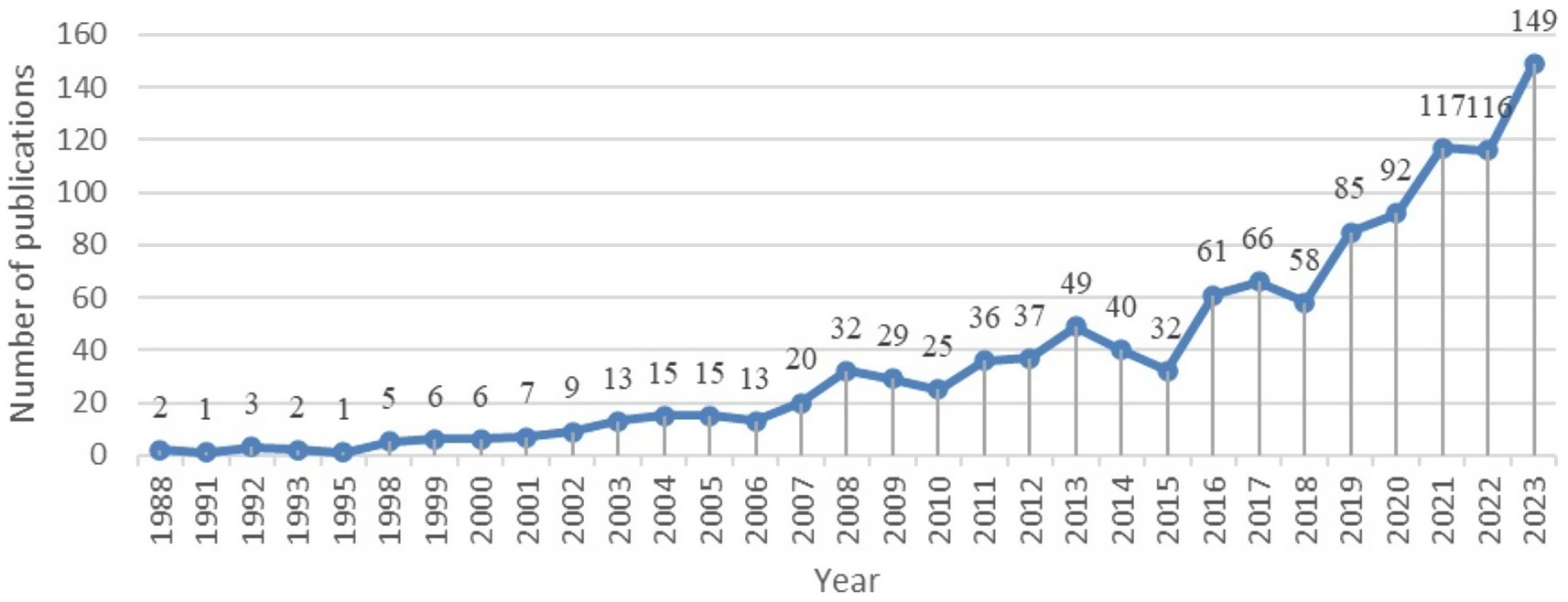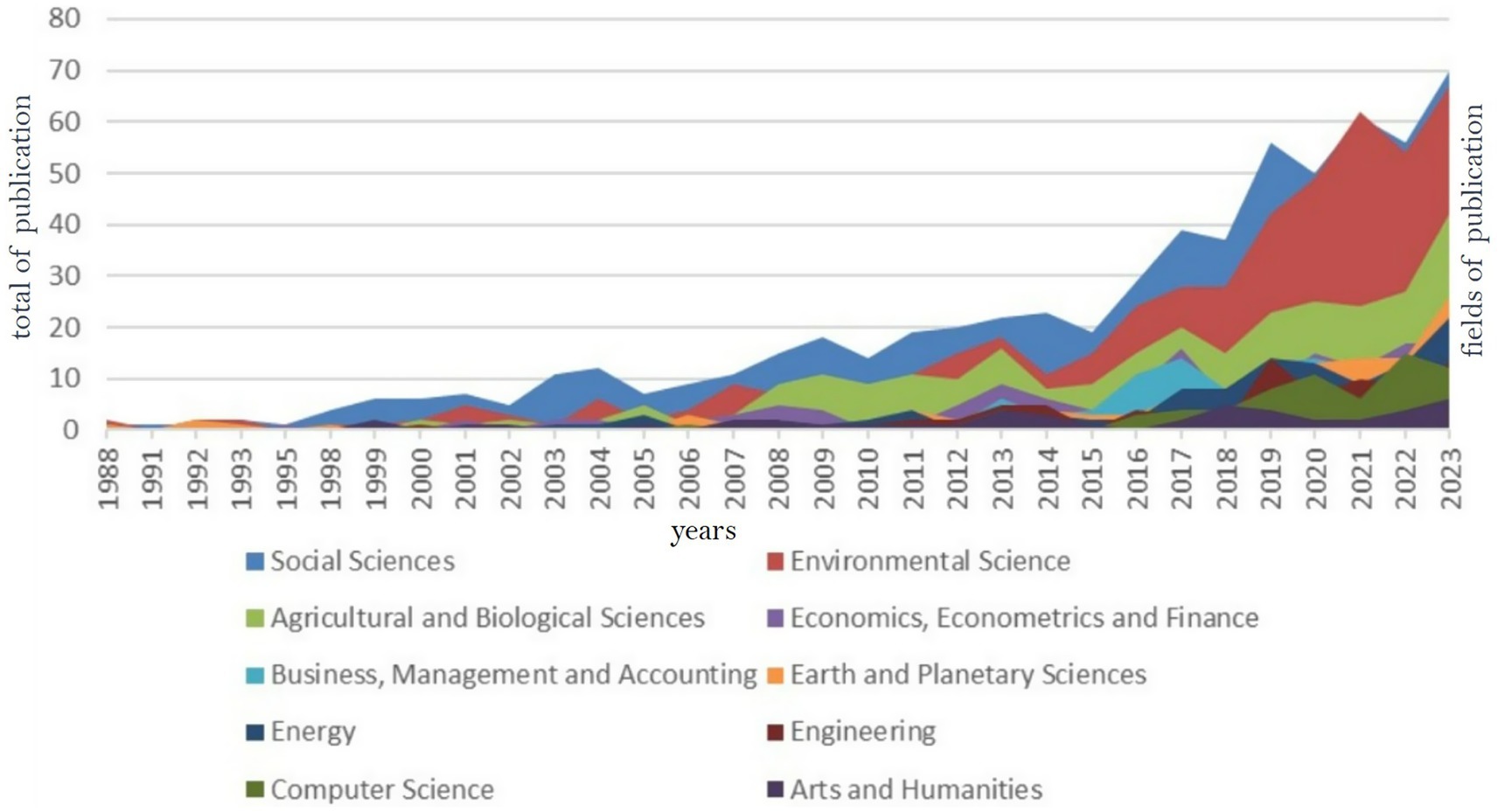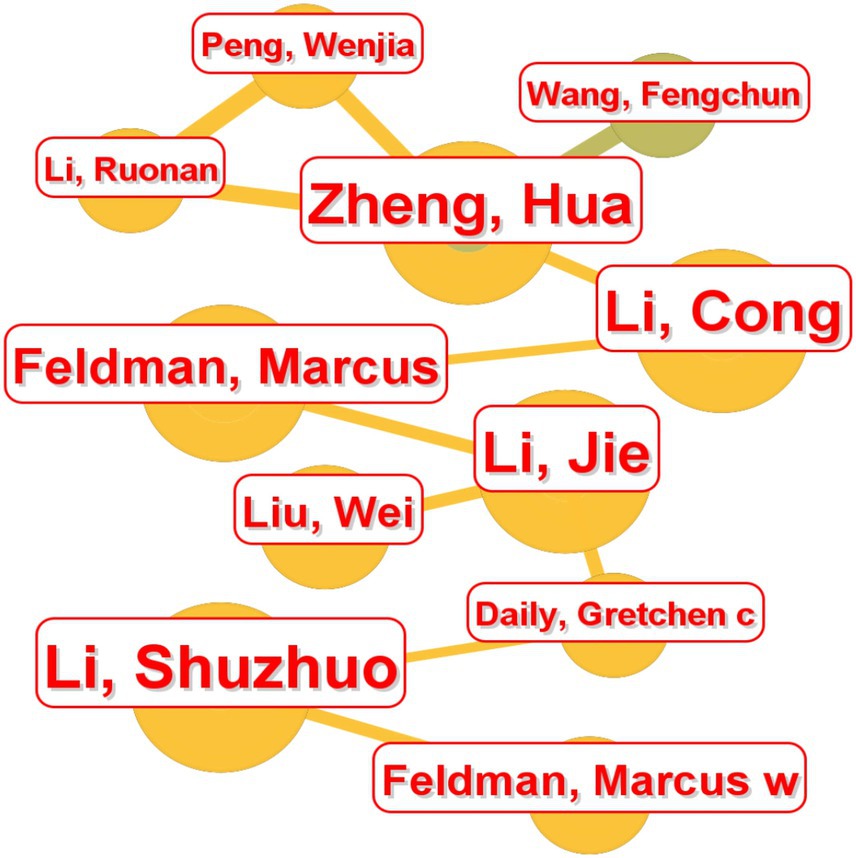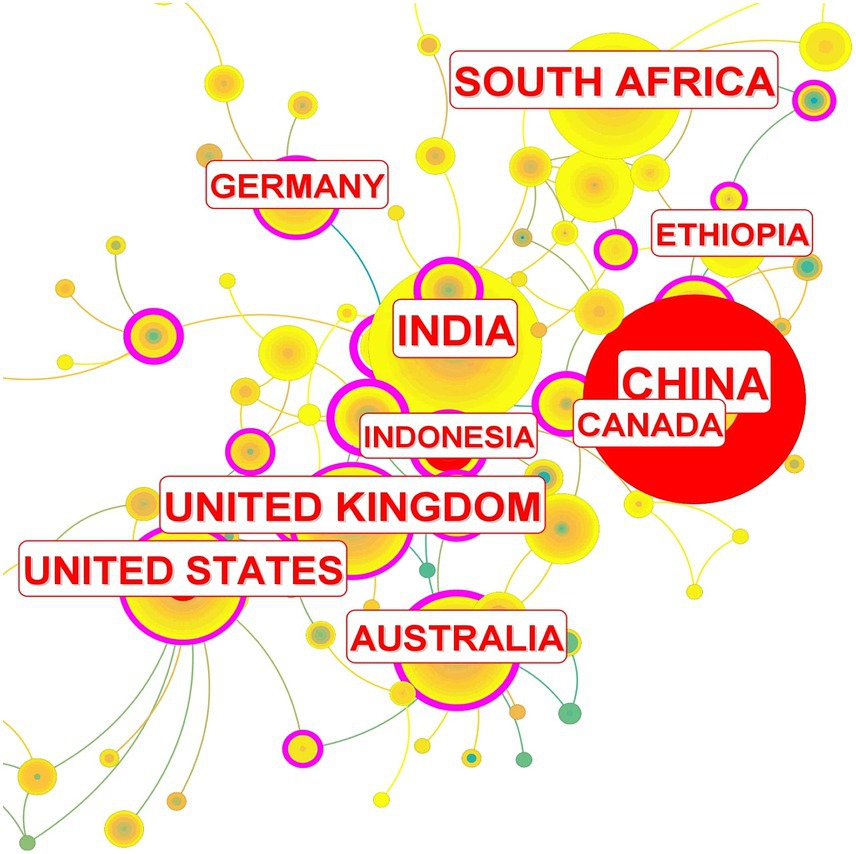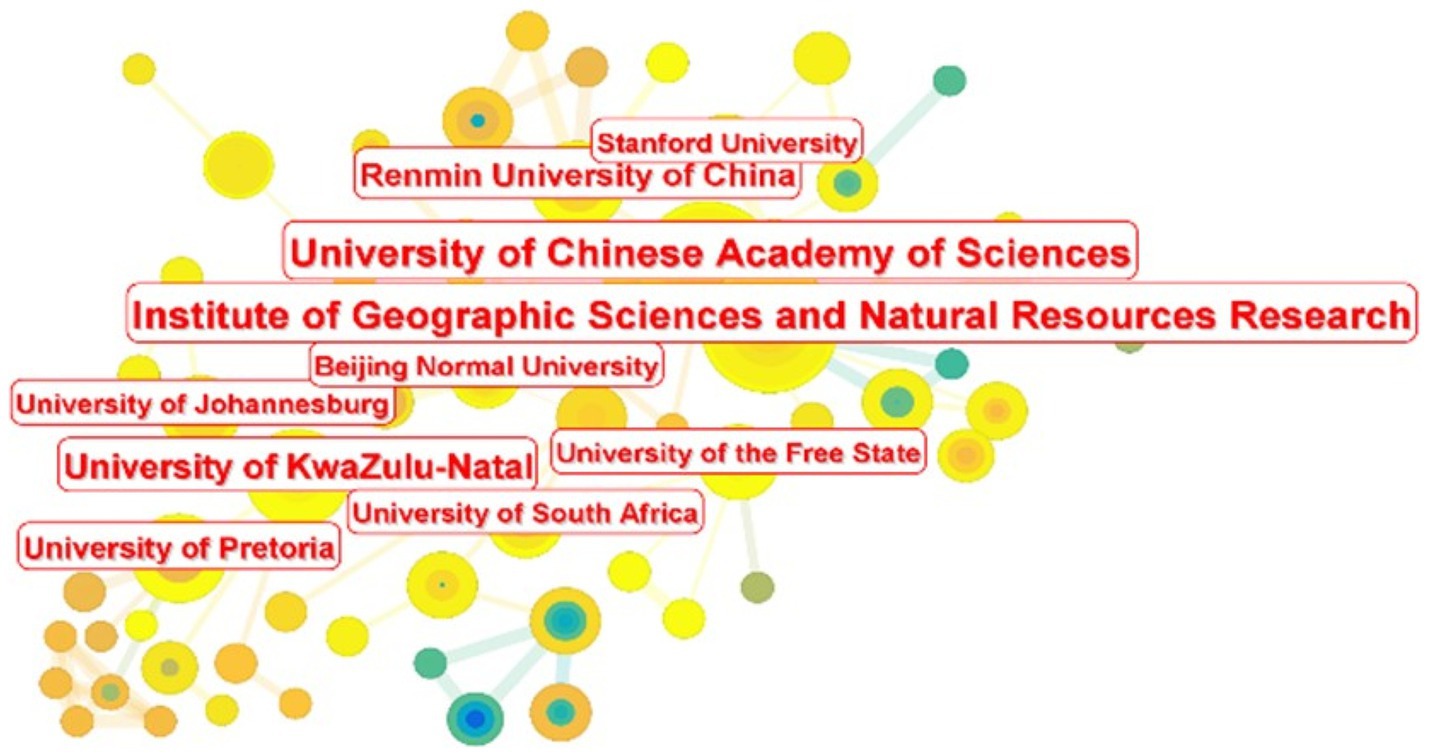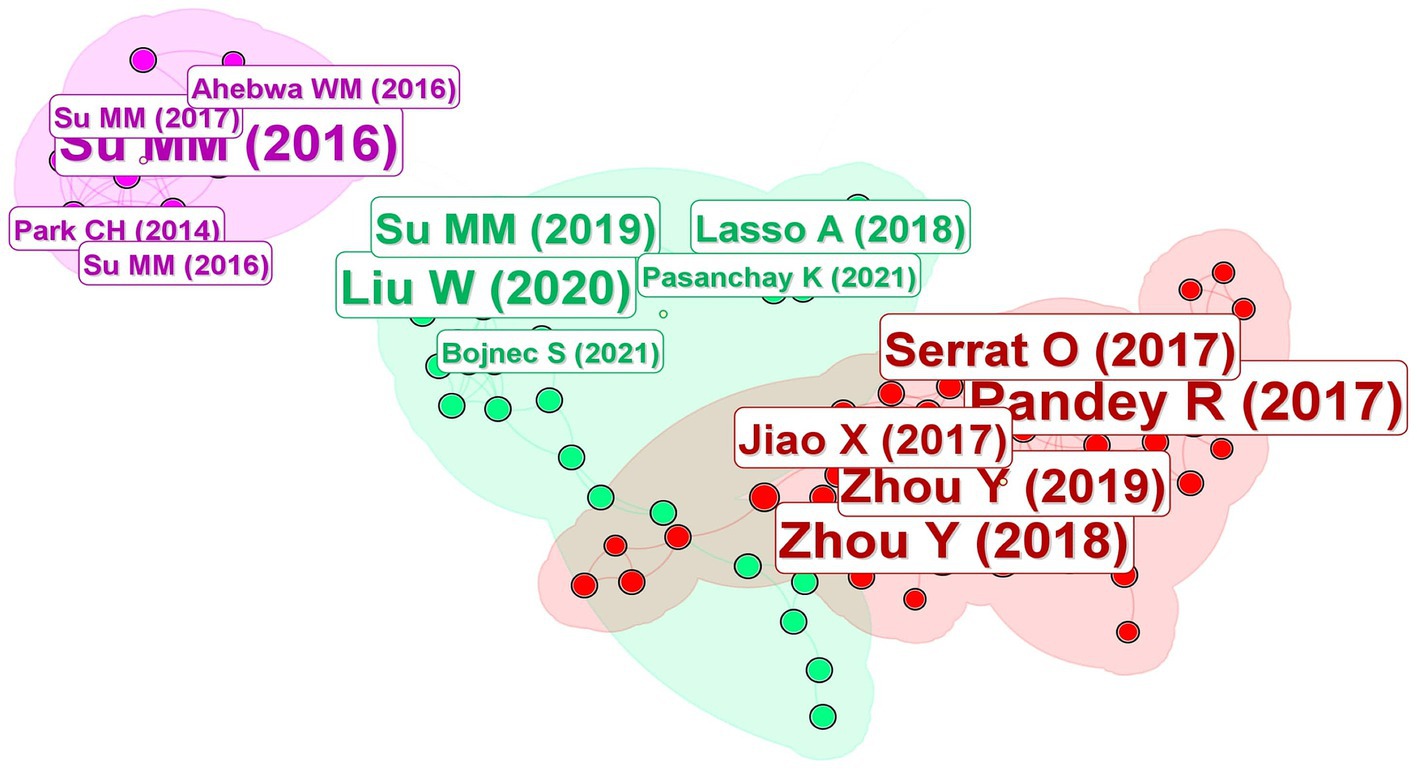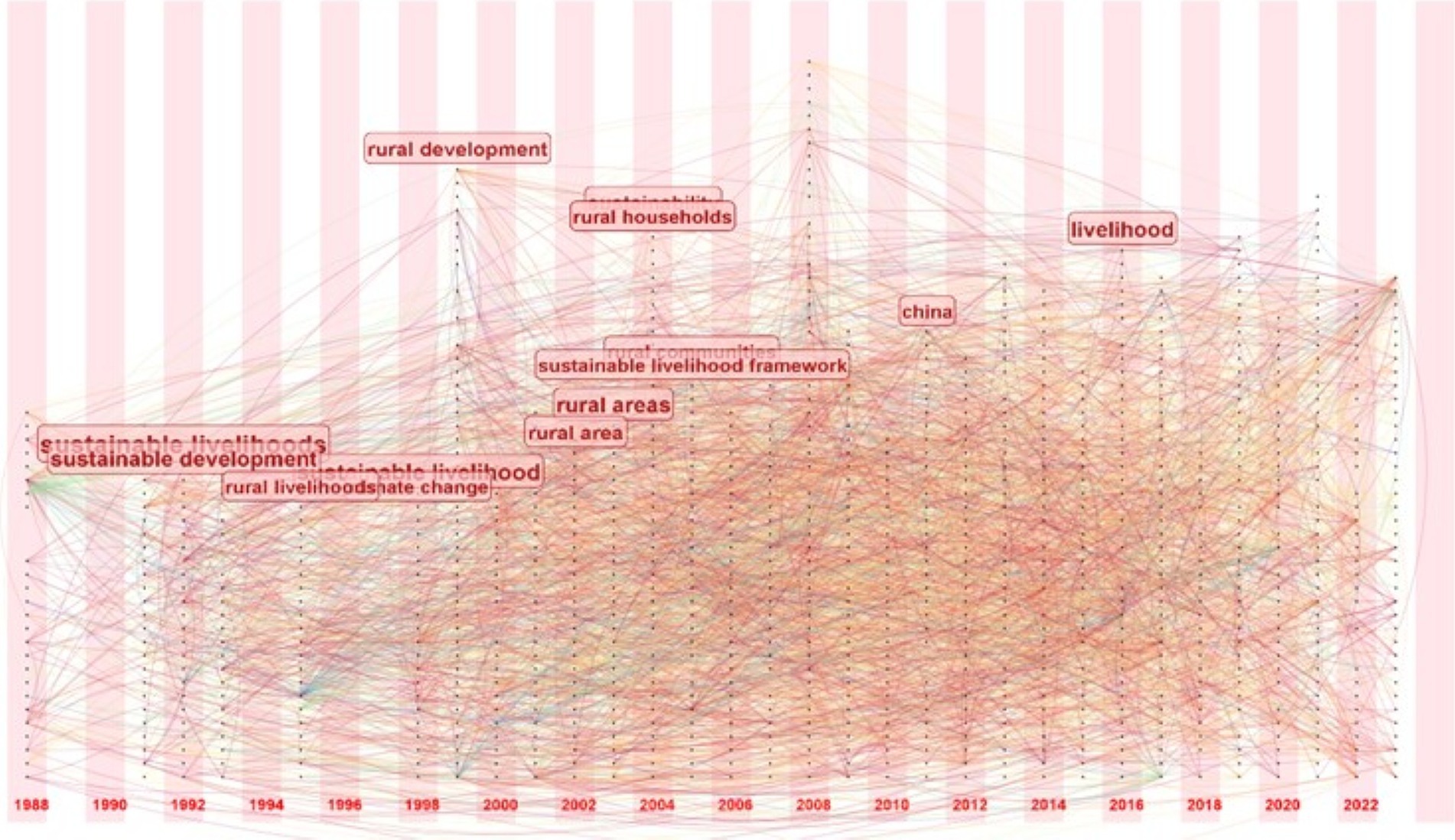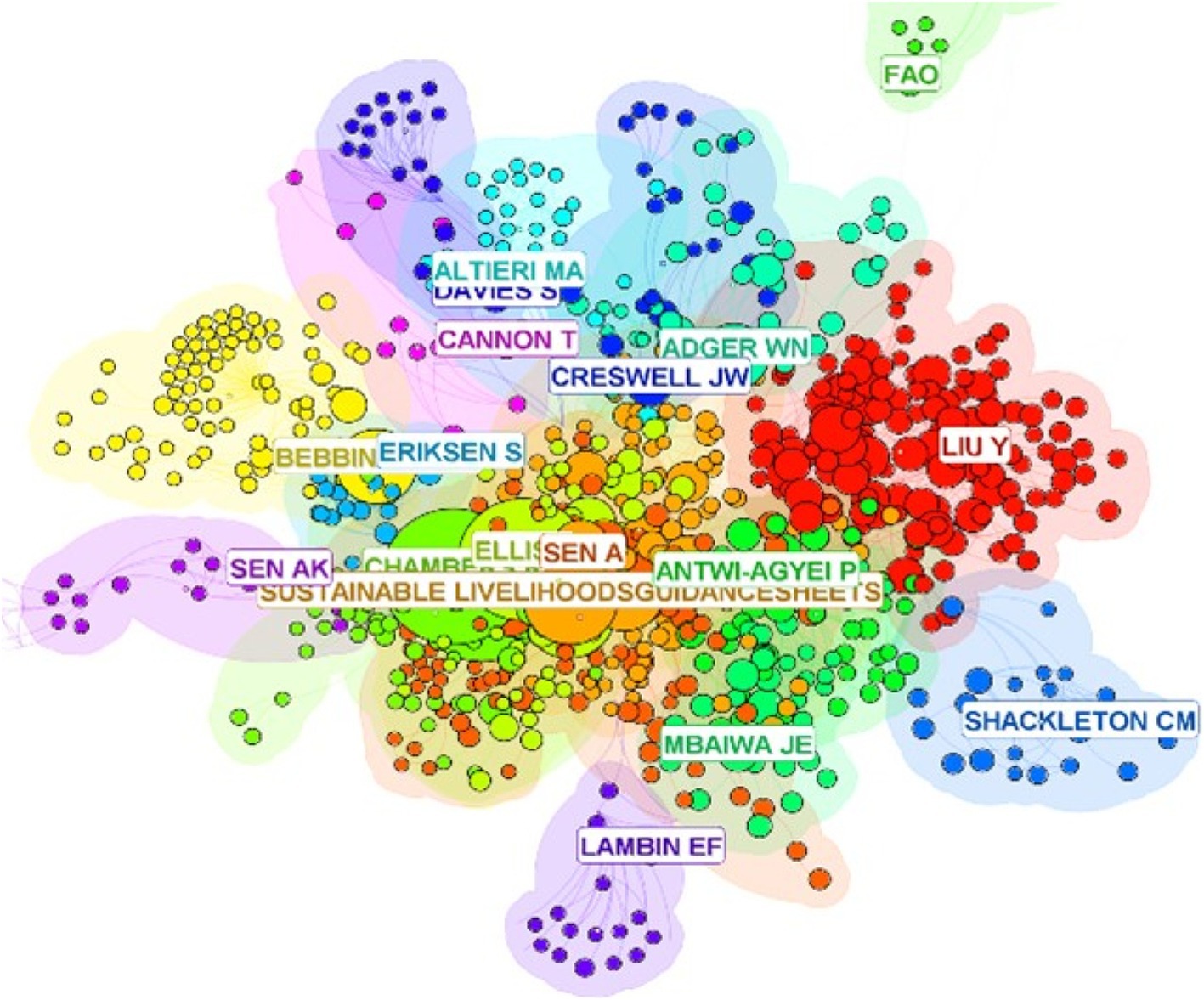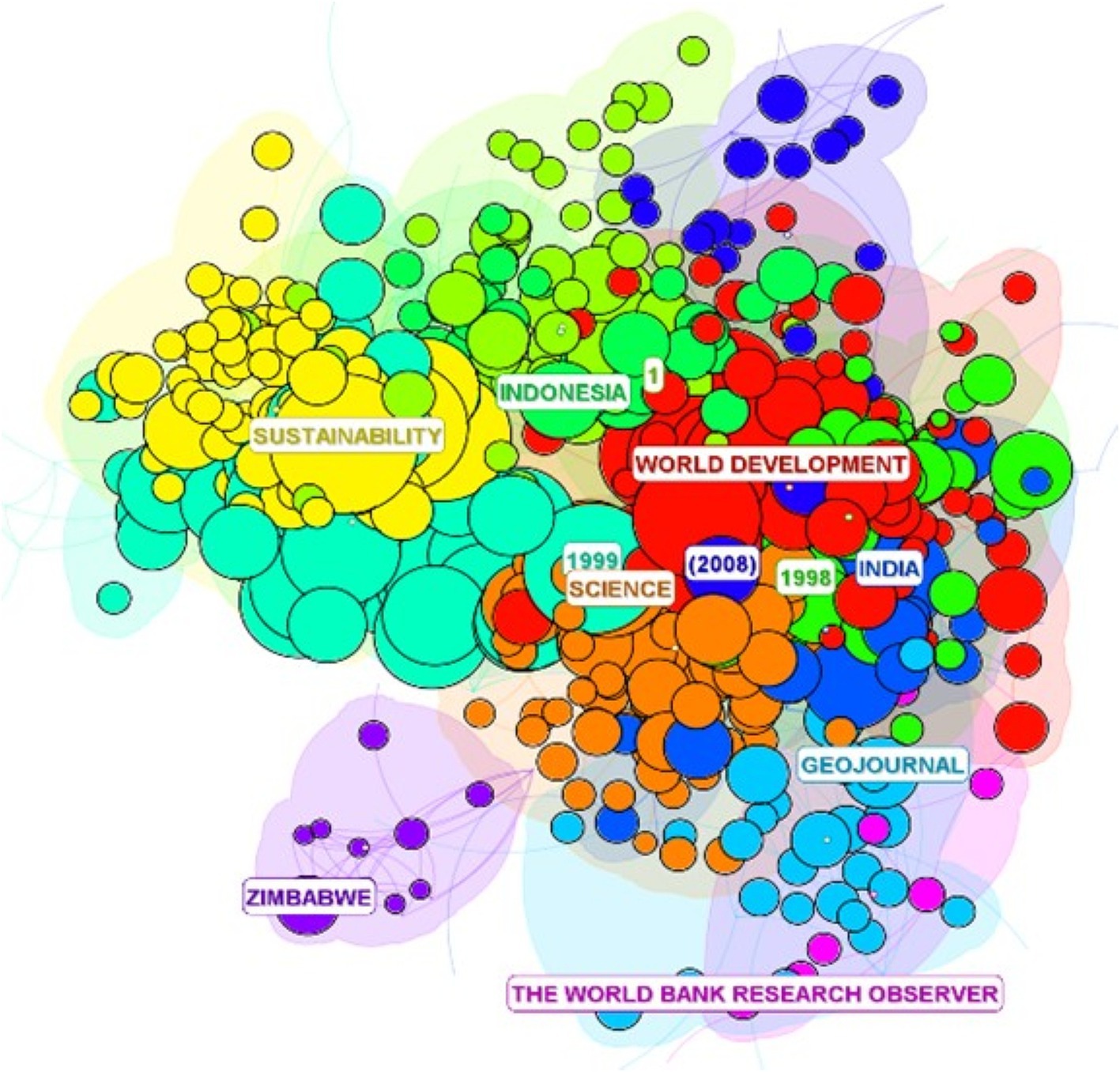- 1Department of Government Science, Hasanuddin University, Makassar, Indonesia
- 2Gender & Depelovment Studies, Begum Rokeya University, Rangpur, Bangladesh
Introduction: The issue of rural sustainable livelihoods has gained significant academic attention due to global concerns such as poverty, climate change, and rural development disparities. Despite a growing body of literature, a comprehensive mapping of this field’s intellectual landscape is still lacking.
Methods: This study employed a scientometric approach using CiteSpace software to analyze 1,141 articles indexed in Scopus from 1988 to 2023. The analysis included citation patterns, co-authorship networks, co-citation structures, and keyword co-occurrence to examine research evolution, key contributors, and collaboration intensity.
Results: The research trend followed four phases: preparation, initial growth, rapid expansion, and stabilization. The field is highly interdisciplinary, bridging environmental sciences, social sciences, and economics. However, author, institutional, and international collaborations remain sparse. China, India, and South Africa were identified as leading contributors, while dominant themes included climate change adaptation, sustainable livelihood frameworks, and social capital.
Discussion: The results highlight the fragmented nature of research networks and the need for greater cross-disciplinary and cross-regional collaboration. Future research should address thematic gaps such as gender equality and digital innovation in rural development. This study offers critical insights for shaping integrative and policy-relevant strategies for sustainable rural livelihoods.
1 Introduction
In recent decades, the issue of sustainable livelihoods in rural areas has gained increasing attention from researchers, policymakers, and practitioners worldwide (Scoones, 2015). This heightened interest is driven by the urgent need to address the complex challenges faced by rural communities, including poverty, climate change, vulnerability to natural disasters, and shifting development policies (Keating et al., 2017; Tucker et al., 2015). The concept of sustainable livelihoods offers a holistic approach to understanding how individuals and households in rural areas can manage their resources sustainably while meeting their basic needs (Quandt, 2018). In this context, it is crucial to identify and analyze the patterns, trends, and recent developments in research on sustainable livelihoods to ensure that efforts are directed effectively and efficiently.
As governments, NGOs, and international organizations prioritize sustainable development goals (SDGs), the importance of understanding the dynamics of rural livelihoods has grown substantially. The existing literature on rural sustainable livelihood is extensive, but it often focuses on case studies, specific regions, or particular dimensions (e.g., agriculture and water management). This creates a gap in understanding the broader intellectual landscape, including how the field has evolved over time, key thematic areas, and collaborations between scholars. While there are bibliometric studies on sustainability and rural development, a focused scientometric analysis specifically on rural sustainable livelihoods has not been conducted to map its scholarly trends, collaborations, and knowledge networks. This research aims to fill this gap by providing a systematic and quantitative overview of the field’s research landscape.
Several thematic strands have shaped the study of rural sustainable livelihoods. Early conceptualizations emphasized diversification strategies and household resilience (Zhang et al., 2023), highlighting how rural households adapt to socio-economic and environmental uncertainties. Subsequent research has explored climate change adaptation in rural communities (Antwi-Agyei and Stringer, 2021), demonstrating the role of adaptive capacity in securing long-term sustainability. Studies on social capital and community-based resource management (Rusli et al., 2024) have revealed how social networks, collective action, and institutional support shape rural development. Additionally, agricultural sustainability and food security (Charoenratana et al., 2021) have remained central themes, with research emphasizing sustainable farming practices, agroecology, and land tenure security. More recently, scholars have examined the role digital inclusion and technological innovation in enhancing rural livelihoods (Kitole et al., 2024), illustrating how access to ICT and financial technology fosters economic opportunities in rural areas.
Despite the breadth of studies on rural sustainable livelihoods, there has been no comprehensive attempt to systematically map the evolution of this research field using scientometric analysis. Scientometric approaches have been widely applied to sustainability science, environmental governance (Aria and Cuccurullo, 2017), and rural development (Morse and McNamara, 2013). These studies have provided quantitative insights into publication trends, key research clusters, and collaboration networks, helping schoolar understand how knowledge production evolves over time. However, a dedicated scientometric analysis of rural sustainable livelihoods remains absent, leaving gaps in our understanding of the field’s intellectual structure, dominant research themes, and the degree of international collacboaration among scholars. Without such an analysis, it is difficult to identify emerging trends, knowledge gaps, and underexplored intersections between disciplines.
Given these gaps, this study seeks to fill a crucial void in the literature by conducting a scientometric analysis of rural sustainable livelihoods research from 1988 to 2023. Unlike traditional narrative reviews, which often focus on specific aspects of livelihoods, a scientometric approach enables a relationship. This study will address several key questions: (1) How has research on rural sustainable livelihoods evolved over the past three decades? (2) Which countries, institutions, and scholars have played a leading role in shaping this field? (3) What are the dominant research themes, and how have they shifted over time? and (4) Where do research gaps exist, and what directions future studies take?. By answering these questions, this study contributes to a deeper understanding of knowledge structures, research trajectories, and interdisciplinary integration in rural livelihood studies.
In addition to the research gap, a knowledge gap exists in terms of how rural sustainable livelihood research interacts with other critical issues, such as climate adaptation, gender equality, and technological innovation. The lack of integration between these areas limits the development of more holistic approaches to rural sustainability. By conducting a scientometric analysis, this study seeks to bridge this knowledge gap by identifying cross-disciplinary intersections and emerging trends that can inform more integrated approaches to rural livelihood sustainability.
This study is significant because it provides a deeper understanding of how research on sustainable livelihoods has evolved over time. Through scientometric analysis, researchers can explore data related to scientific publications, such as the number of published articles, the impact of research, author collaboration, and citation networks. The results of this analysis can identify areas of research that have been extensively studied, as well as areas that have received less attention, thereby assisting researchers and policymakers in formulating more targeted strategies for developing sustainable livelihood programs and policies in rural areas.
Furthermore, this research mapping can provide insights into collaborations among various institutions, countries, and researchers in the field of sustainable livelihoods. By understanding the collaboration networks and contributions of different actors, this study can help enhance cooperation and synergy in achieving sustainable livelihoods. Additionally, this analysis can serve as a guide for future research by highlighting relevant trends and directions, helping new researchers determine their focus and contributions in this important domain.
2 Materials and methods
The methodology employed in this study consists of data extraction and scientometric analysis using CiteSpace V.6.3.R2 Advanced software. Figure 1 shows the research procedure, the data extraction process begins with selecting Scopus as the primary database, followed by the development of a search strategy using keywords such as ‘sustainable livelihood’, ‘rural development’, and ‘rural’. The scientometric analysis stage involves an in-depth examination of the research landscape, including citation patterns, collaboration networks, and keyword co-occurrences (Malanski et al., 2021, 2022). Using CiteSpace, the study generates scientific maps to visualize trends, research clusters, and influential contributors, providing a comprehensive overview of the knowledge structure in the field of rural sustainable livelihoods (Ansar, 2024).
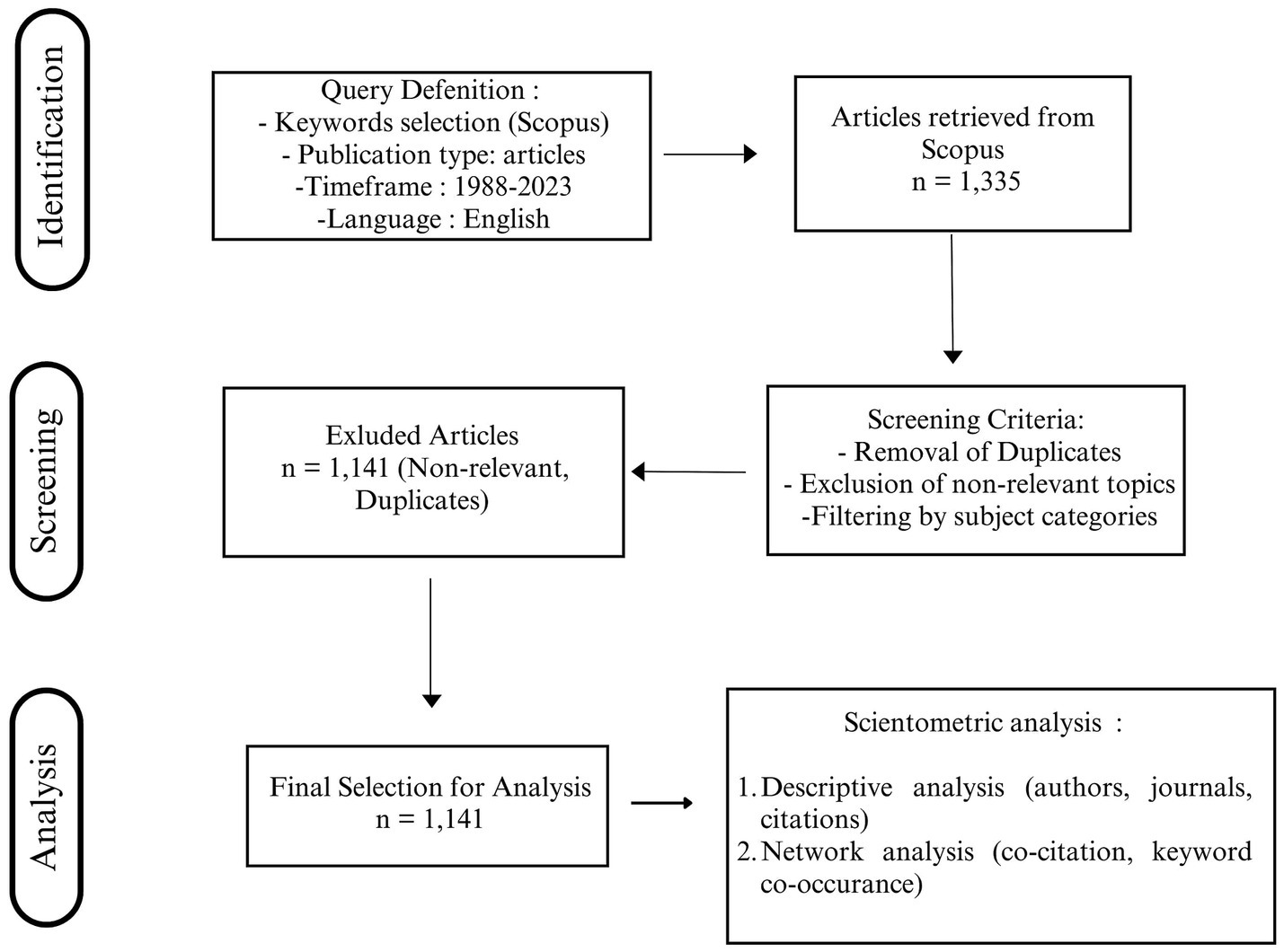
Figure 1. Research design. Source: Malanski et al. (2021, 2022), modified by Authors.
2.1 Data collection
The data collection began with accessing the Scopus database, which is renowned for its extensive collection of peer-reviewed literature across a multitude of academic disciplines (Schotten et al., 2017). We employ the keywords “sustainable livelihood” and “rural development” or “rural” in document searches within the article title, abstract, and keywords. Following the execution of the search, various filters within Scopus were performed to streamline the results according to specific parameters, such as publication years between the beginning of the publications (1988) and limited to December 2023. The selection of this period follows an ex-post approach, meaning that the time frame was determined after reviewing the availability of relevant publications in Scopus, rather than being predefined beforehand (ex-ante). The identification of 1988 as the starting point was based on the earliest available publication related to rural sustainable livelihoods within the dataset, ensuring that the study comprehensively captures the intellectual evolution of the field. The endpoint of 2023 was chosen to include the most recent publications, reflecting emerging trends and ongoing scholarly contributions. By using an ex-post approach, the study ensures that the selected time frame is data-driven, avoiding arbitrary temporal constraints and maximizing the completeness and validity of the scientometric analysis. Once the desired articles have been identified, the subsequent step is to export the citation data. In this study, a dataset of 1,141 documents in.csv format was exported from Scopus.
The use of Scopus as the primary database for this scientometric analysis is justified by its comprehensive coverage, structured metadata, and compatibility with scientometric tools like CiteSpace. With over 25,000 peer-reviewed journals, Scopus ensures high-quality, curated publications across disciplines relevant to rural sustainable livelihoods. Its integration with bibliometric software enables robust citation analysis, author collaboration mapping, and thematic trend identification.
With the prepared dataset, the data was imported into CiteSpace, where the software facilitates the visualization and analysis of citation patterns, author collaborations, and keyword co-occurrences (Chen, 2006, 2014). This tool allows users to adjust parameters such as time slicing and node types to explore various facets of their dataset effectively. The resulting visualizations reveal trends, clusters, and influential authors, providing a comprehensive understanding of the research landscape (Wang and Lu, 2020). Ultimately, the outcomes of this scientometric analysis can illuminate gaps in existing literature, highlight emerging topics, and inform future research directions within the domain of sustainable livelihoods and related fields.
The 1988–2023 timeframe is chosen to ensure a comprehensive and methodologically sound scientometric analysis of rural sustainable livelihoods. The late 1980s marked the emergence of the sustainable livelihood approach as a multidisciplinary framework, integrating social, economic, and environmental dimensions. Over the 2000s, research expanded to address climate resilience and socioeconomic sustainability, while the 2010s saw greater interdisciplinarity, incorporating digital inclusion, financial innovation, and social capital. Analyzing this period captures key intellectual shifts sshapes by technological advances, policy changes, and environmental challenges.
Methodologically, this timeframe aligns with scopus, ensuring robust data coverage for identifying publication trends, collaboration networks, and thematic shifts. A shorter period would risk overlooking long-term patterns and interdisciplinary developments. The selection also coincides with major global policy milestones: the Keeble Report (Keeble, 1988), MDGs (2000–2015), and SDGs (2015–2030), all of which have shaped rural sustainability discourse. Including 2023 ensures relevance by capturing the latest trends in climate adaptation, digital transformation, and policy innovation. This study, therefore, provides a rigorous and up-to-date overview of the evolving research landscape in rural sustainable livelihoods.
2.2 Data analysis
2.2.1 Collaboration analysis
It is a methodological approach designed to elucidate the relationships and networks among researchers, institutions, and countries in a particular field of study. This analysis involves examining co-authorship and co-citation patterns, which provide insights into how knowledge is produced and disseminated within academic communities. The process begins with the collection of bibliographic data from reputable databases, such as Scopus or Web of Science, where we can specify search criteria relevant to their research area (Chen, 2006). Once the data is gathered, it is imported into CiteSpace, a powerful visualization tool that facilitates the mapping of collaborative networks.
In CiteSpace, the co-authorship analysis allows researchers to identify key authors and their collaborative relationships within the selected literature. By visualizing these connections, it is possible to determine the centrality of authors, revealing which individuals or institutions are at the forefront of research in a given field. This network visualization aids in understanding the distribution of collaborative efforts, highlighting patterns of cooperation and potential silos within the research community (Chen et al., 2010). Moreover, the analysis can be extended to institutional and country-level collaborations, providing a broader perspective on global research dynamics and the interconnectedness of various stakeholders.
Furthermore, CiteSpace’s ability to generate visual representations of collaboration networks enhances the interpretability of complex data. The maps display nodes representing authors or institutions, with links indicating collaborative ties. Metrics such as degree centrality, betweenness centrality, and clustering coefficients can be calculated to quantify collaboration patterns, further enriching the analysis (Isfandyari-Moghaddam et al., 2023; Reyes-Gonzalez et al., 2016). Through collaboration analysis, researchers can identify influential contributors, emerging research trends, and potential areas for future investigation, thereby informing strategic decisions in research policy and funding.
2.2.2 Co-citation analysis
It is a valuable method employed in scientific research to investigate the relationships and intellectual structure of a specific field through the examination of citation patterns among academic documents. This analytical technique identifies how often two or more documents are cited together in the same reference list, providing insights into the thematic connections between them (Nowell et al., 2017; Terry et al., 2017). In the context of using CiteSpace, co-citation analysis facilitates the visualization of these relationships, enabling researchers to map the intellectual landscape and discern clusters of related literature within a particular area of study (Wu et al., 2019).
To conduct co-citation analysis in CiteSpace, we begin by collecting bibliographic data from a reputable database, Scopus. This dataset should include the citation information of the relevant documents, including their titles, authors, publication years, and references. After importing this data into CiteSpace, the software processes it to identify and visualize co-citation relationships, resulting in a network of nodes (representing documents) and links (indicating co-citation occurrences). Researchers can adjust various parameters, such as time slicing and node types, to refine the analysis and focus on specific aspects of the literature (Chen, 2016).
The resulting visualizations allow us to identify influential documents, emerging trends, and the evolution of concepts over time. By analyzing the co-citation networks, we gain insights into the intellectual foundations of a discipline, recognizing core theories, methodologies, and seminal works that shape the field (McLaren and Bruner, 2022). Furthermore, the identification of clusters—groups of documents that are frequently co-cited—can reveal subfields or specialized areas of research, aiding in the identification of gaps in the literature and potential directions for future investigation (Chen, 2006; Chen et al., 2012). Overall, co-citation analysis serves as a powerful tool for understanding the structure and dynamics of knowledge production in any academic domain.
2.2.3 Co-citation analysis
In the context of keywords, is a methodological approach used to identify and visualize the relationships between terms that appear together in academic literature. This analysis is essential for understanding the thematic structure of a research field, revealing how concepts and topics are interrelated over time. By analyzing keywords that frequently co-occur in a given set of documents, researchers can uncover emerging trends, dominant themes, and potential areas for future investigation (Zhou et al., 2022).
In CiteSpace, the process begins with the collection of bibliographic data from comprehensive databases such as Scopus, where we specify relevant search criteria based on their research focus. Once the data is imported into CiteSpace, the software enables users to extract and analyze keywords from the selected literature. We set parameters such as time slicing and thresholding to refine the analysis, which facilitates the identification of keywords that frequently co-occur within the same publications. The software generates a visual representation of these relationships, where nodes represent keywords and links signify co-occurrences, creating a network that highlights key themes within the literature (Chen, 2006).
The resulting keyword co-occurrence network allows us to visualize clusters of related terms, providing insights into the development of research topics and the evolution of academic discourse over time. By examining the centrality and burstiness of keywords, scholars can identify pivotal concepts that have gained prominence in recent years, indicating shifts in research focus or emerging areas of interest (Tiernan et al., 2019). Furthermore, co-occurrence analysis can reveal gaps in the literature, guiding future research directions and informing policy-making and practice (Lozano et al., 2019). Overall, keyword co-occurrence analysis in CiteSpace serves as a robust tool for elucidating the structure and dynamics of knowledge production in various academic disciplines.
3 Results and discussion
3.1 Publications and categories in rural sustainable livelihood
Figure 2 shows the development of publications on rural sustainable livelihood for 35 years period 1988–2023. This consistent growth indicates that the research area is gaining more attention, and researchers are contributing more actively, possibly due to increased funding opportunities, advancements in research methodologies, or a heightened global interest in the topic.
1. Preparation Growth (1988–2006). During this phase, research related to sustainable rural livelihoods was relatively scarce, with only a few publications emerging each year. The gradual increase in research output from 1988 to 2006 indicates a foundational period where the field began to establish its relevance. Researchers explored initial concepts and frameworks, laying the groundwork for future studies. This phase served as a preparatory stage, setting the foundation for the subsequent rise in academic interest.
2. Initial Growth (2006–2018). The period from 2006 to 2018 saw a steady increase in the number of publications, reflecting an initial growth phase for the research field. As the topic gained recognition, there was a broader acceptance and integration of sustainable rural livelihood studies across various disciplines. This period marked the emergence of key themes and methodologies, as well as a more structured research agenda. Increased collaboration and support from academic institutions and policy organizations likely contributed to this growth, building momentum for the field.
3. Rapid Growth (2018–2020). From 2018 to 2020, the field experienced a phase of rapid growth, characterized by a sharp rise in the number of publications. This surge indicates a significant expansion in research activities, possibly driven by new funding opportunities, global events, or heightened relevance of the topic in addressing sustainability challenges. Researchers from various disciplines increasingly converged on this topic, contributing diverse perspectives and methodologies. The rapid growth phase was crucial in establishing the field as a prominent area of academic and practical inquiry.
4. Stabilization and Maturation (2020–2023). The final phase, spanning from 2020 to 2023, marks a period of stabilization and maturation. During this time, the number of publications remained relatively steady, reflecting a consolidation of the research field. This phase indicates that the field had reached a level of maturity, where the focus shifted towards refining existing theories, addressing research gaps, and exploring interdisciplinary collaborations. The stable output suggests that the field has gained a robust foundation, with researchers delving deeper into complex issues and providing nuanced insights to influence policy and practice in rural sustainability.
The progressive rise in publications indicates an escalating global recognition of rural sustainability challenges. During the Preparation Growth stage, researchers established foundational concepts, which set the scene for broader, more integrated studies in the following phases. By Initial Growth and Rapid Growth, factors such as climate imperatives, poverty alleviation needs, and shifts in development policies prompted more interdisciplinary collaboration, involving specialists in social sciences, environmental studies, and agricultural economics.
In practice, the maturation phase suggests that many core debates—like climate resilience or rural resource management—have become mainstream. However, ensuring genuine interdisciplinary synergy remains a challenge, as there is risk of parallel effort lacking a common methodological framework. Moving forward, scholars might adopt integrative models (e.g., socio-ecological systems or social-ecological-technological systems) to capture the breadth of factors influencing rural livelihoods and to inform more holistic policy solutions.
Figure 3 shows the development of publications from 1988 to 2023 across several fields (e.g., Social Sciences, Environmental Science, Economics, Econometrics and Finance). There has been a significant increase in publications related to sustainable rural livelihoods in various fields since 2000, particularly in Environmental Science and Social Sciences. This indicates that sustainability issues in rural areas have garnered more academic attention over the past two decades. The number of publications increased sharply starting in 2005. For example, if in the year 2000 the total number of publications in all fields was around 5–10 per year, by 2014 this number rose to over 40 publications per year.
Environmental studies have shown significant growth since 2005. This indicates that much of the research on rural sustainability focuses on environmental aspects, including the sustainability of natural resources, climate change adaptation, and land management in rural areas. Contributions from the social sciences have also increased sharply, especially during the 2010–2014 period. This suggests that social issues, such as community participation, local institutions, and social policies, have become a major focus in efforts to create sustainable livelihoods in rural areas.
Furthermore, research in the agricultural and biological sciences show a steady but significant trend, indicating that agricultural and biological aspects (e.g., sustainable agricultural technologies, biodiversity conservation) are integral to rural livelihood studies. Overall, research on sustainable rural livelihoods is interdisciplinary in nature. Social Sciences often collaborate with Environmental Sciences, while Economics tends to intersect with research in Management and Business. This suggests that understanding sustainable rural livelihoods cannot be viewed from a single perspective but requires a multidisciplinary approach.
3.2 Collaboration network analysis
3.2.1 Authors
The author collaboration network analysis reveals a relatively low degree of interconnection among authors in the field, as indicated by a network density of 0.004 (Figure 4). With 233 nodes (representing distinct authors) and 108 links (collaborative relationships), the network is sparse, suggesting that collaboration is limited, and many authors work either independently or within small groups. This sparse network structure indicates that while there are collaborations occurring, they are not widespread, and there is potential for further expansion and integration of collaborative research efforts among authors.
In terms of publication frequency, the most prolific author is Xu Dingde, with 8 publications, followed by Min Qingwen and Li Shuzhuo, each with 6 publications. This highlights these authors as key contributors to the research area, indicating their active engagement and influence in shaping the discourse within the field. For instance, Xu et al. (2015) finds that approximately 56% of households in the Three Gorges Reservoir area have low dependence on agriculture, with key factors such as education, age of the household head, labor force, location, and social networks influencing their livelihood strategies. It recommends that government investment in infrastructure and favorable loan policies encourage rural populations to leverage social networks for business opportunities in migrant destinations.
Other authors, such as Zheng Hua, Li Jie, and Wall Geoffrey, with 5 publications each, also show considerable participation, but not as prominently as the top three. The frequent appearances of these names in the collaboration network suggest that they might be central figures within their research communities or specific subfields, and their work could serve as a foundation for future research directions.
Despite the notable productivity of these authors, the low network density highlights limited cross-collaboration, possibly leading to overlapping yet isolated research agendas. Such fragmentation can hamper the exchange of new ideas or comparative data across regions. Research institution could alleviate this br promoting co-authorship arrangements, shared project, or joint supervision of postgraduate researchers. These measures not only broaden authos’ perspectives but also help unify theoretical frameworks that underpin rural sustainable livelihood studies.
3.2.2 Countries
The analysis of the country collaboration network reveals a structured yet relatively sparse distribution of research collaborations across 114 countries, with 145 collaborative links connecting them (Figure 5). The network density of 0.022 indicates that, despite having a considerable number of countries engaged, the connections between them are not uniformly strong or widespread. This suggests that while some countries have robust collaborative ties, the overall network still has potential for growth in fostering more interconnected research activities globally. Countries with more links tend to form hubs or clusters within the network, highlighting their roles as key players in international research collaborations.
When examining publication frequency, China (236), India (155), and South Africa (113) emerge as the leading contributors with the highest number of publications, reflecting their active involvement and substantial influence in the research landscape. China, in particular, stands out with 236 publications, indicating its dominant position. This high output suggests that these countries are not only conducting extensive research but also potentially shaping the research agenda and themes in the field. Meanwhile, traditional research powerhouses like the United States (111) and the United Kingdom (107) continue to maintain a strong presence, although their publication counts are relatively lower compared to the top three contributors.
The prominence of China, India, and South Africa correlates with their vast rural regions and the policy relevance of sustainable livelihood research in these locales. Thailand’s elevated centrality implies it is a hub bridging collaborations across different countries. Strengthening these networks through expanded South–South cooperation could facilitate the sharing of practical, context-aware solution, ranging from land-management techniques to financial-icnlusion programs. In turn, such partnerships could accelerate progress toward global sustainability targets, including the SDGs.
On the other hand, centrality analysis provides insight into the pivotal roles certain countries play in linking the network together. Thailand, with a centrality value of 0.65, is the most crucial intermediary, acting as a bridge between countries that might not have direct collaborations. Malaysia and Australia also show high centrality values, reflecting their strategic importance in facilitating international research cooperation. Countries like Indonesia, despite having fewer publications (29), demonstrate significant centrality (0.25), suggesting they are positioned to connect different research clusters. These findings highlight that while publication volume is essential, a country’s central role in the network can be equally influential in promoting global research integration and knowledge dissemination.
3.2.3 Institutions
The analysis of the institution collaboration network demonstrates a relatively low level of interconnectedness, as indicated by the network density of 0.002 (Figure 6). With 512 nodes (institutions) and 282 links (collaborative ties), the network is quite sparse, suggesting that many institutions are conducting research independently or in smaller collaborative clusters. This low density reflects the potential for expanding and strengthening collaborations between institutions, especially among those that currently have fewer links. The observed sparsity could be due to geographic, disciplinary, or institutional barriers that hinder more extensive cooperation.
In terms of publication frequency, the Institute of Geographic Sciences and Natural Resources Research (IGSNRR) and the University of Chinese Academy of Sciences emerge as the top contributors, with 21 and 20 publications, respectively. Their dominance indicates that these institutions are heavily invested in the research field and are likely to be influential in shaping the research agenda. South African institutions, such as the University of KwaZulu-Natal and the University of Pretoria, are also among the top contributors, reflecting their active participation and regional prominence in the research landscape. The presence of African and Chinese institutions at the forefront signifies a growing contribution from these regions, potentially indicating regional research hubs.
While IGSNRR and the University of Chinese Academy of Sciences rank highly in publication output, their lower centrality suggests they are not fully bridging separate institutional clusters. Encouraging collaborative grants or cross-lab partnerships could help disseminate valuable insight and prevent duplicative efforts. Likewise, smaller institutions stand to benefit by partnering with leading research hubs, gaining both technical expertise and access to broader academic networks—a strategy that can elevate innovation while diversifying the global research ecosystem.
Despite having high publication frequencies, many of these institutions show low centrality values, with most below 0.01. This implies that while they are significant contributors in terms of output, they are not key connectors within the broader collaboration network. Beijing Normal University and the University of Venda, with centrality values of 0.02, are exceptions, serving as more critical nodes that link different clusters. The low centrality of other institutions suggests that collaboration is still concentrated within regional or institutional silos, limiting the formation of a more integrated global research network. Expanding collaborative ties with institutions showing high publication counts but low centrality could enhance all cohesion and knowledge dissemination within the research community.
3.3 Co-citation analysis
3.3.1 Author co-citation
The author co-citation network analysis provides insights into the intellectual structure and influence of authors within a research field based on how frequently they are cited together (Figure 7). With 1,082 nodes (authors) and 3,227 links (co-citation relationships), the network has a low density of 0.005, indicating that while there is a substantial number of co-citation connections, the overall interconnectedness is still limited. This suggests that many authors are cited in relatively isolated clusters or within specific research themes, rather than being part of a highly integrated, cohesive academic network. The low density can imply that while some authors are frequently co-cited, the network does not reflect a uniform spread of co-citation patterns, pointing to potential fragmentation or division in research focus areas.
The strong centrality of authors like Liu Y and Carney D underscores their roles as conceptual linchpins, widely referenced across varied contexts—from climate adaptation to livelihood diversification. Scoones I’s citation burst suggests that certain periods witnessed a heightened focus on sustainable livelihood frameworks. These authors could effectively lead cross-cluster dialogues, initiating comparative research that aligns differing theoretical lenses. This would help unify a field otherwise scattered by diverse local case studies and specialized disciplinary angles.
In terms of centrality, several authors stand out as key nodes within the co-citation network, indicating their central role in linking different authors and research themes. Liu Y has the highest centrality score of 8.26, suggesting that this author is a pivotal figure in the field, frequently co-cited across different research areas, thereby acting as a bridge between various subfields or research topics. Similarly, Zhou Y (6.89), Carney D (6.49), and Serrat O (6.37) also have high centrality values, signifying their importance in connecting different clusters within the network. These authors likely contribute to the theoretical or methodological frameworks that are widely recognized and referenced by scholars across different domains.
The presence of well-established researchers like Blaikie p (5.98) and Rigg J (6.13) further underscores the influence of foundational authors whose work continues to be pivotal in shaping the research landscape. High centrality values for these authors indicate that their contributions are not only highly regarded but also serve as a common reference point for diverse research themes. This shows that while the network has a low density, certain authors play a crucial role in maintaining the structure and coherence of the intellectual landscape. To strengthen the co-citation network, fostering interdisciplinary collaborations and expanding citations across less connected clusters can lead to a more integrated and holistic research community.
3.3.2 Journal co-citation
The journal co-citation network analysis, comprising 746 nodes and 3,370 links, indicates a moderately connected structure, as shown by the network density of 0.012 (Figure 8). The density value suggests that the network is neither too sparse nor too dense, reflecting a well-established pattern of co-citation relationships among journals. In this network, certain journals have formed strong connections through frequent co-citation by the research community, indicating their importance in shaping the discourse and serving as reference points within the field. However, given the relatively low-density value, the network still has room for further integration, implying that there are distinct clusters or thematic areas that have yet to establish stronger interconnections.
When analyzing based on frequency, journals like World Development (254 citations), Sustainability (181 citations), and Land Use Policy (160 citations) emerge as the most frequently cited sources. Their high citation counts highlight their central role in the field and suggest that they are key references for researchers working on sustainable development, land use, and environmental policy. This dominance indicates that these journals are likely setting research agendas and providing foundational theories and frameworks that guide studies in related fields. The frequent appearance of interdisciplinary journals such as Science (153 citations) and Food Policy (133 citations) also demonstrates the cross-disciplinary nature of the research being conducted, integrating insights from different domains to address complex global challenges.
The centrality analysis further elucidates the significance of certain journals within the network. Journals like Agricultural Systems (0.08), Ecological Economics (0.06), and Development and Change (0.06) have the highest centrality scores, indicating their pivotal role as connectors within the network. High centrality values suggest that these journals are instrumental in bridging research clusters and facilitating the flow of information across diverse thematic areas. Interestingly, although World Development has the highest citation frequency, its centrality score (0.05) is lower than that of Agricultural Systems and Ecological Economics, indicating that while it is a heavily referenced source, it may not serve as a primary connector between distinct research areas. This points to the nuanced roles that different journals play in the network: some serve as repositories of knowledge, while others act as conduits, linking various subfields, and facilitating interdisciplinary dialogue.
Frequent citations of World Development, Sustainability, and Land Use Policy point to their broad interdisciplinary appeal. Meanwhile, high-centrality journals like Agricultural Systems and Ecological Economics appear to function as intellectual bridges, connecting diverse fields. Scholars aiming to enhance cross-disciplinary influence might prioritize submitting to these bridging journals, thus raising the visibility and applicability of their research to audiences in environmental policy, economics, and beyond.
In terms of publication output, Sustainability Switzerland leads with 62 publications, followed by Land Use Policy (19) and Land (18). This demonstrates the active role these journals play in disseminating research and contributing to the ongoing academic conversation. The relatively high number of publications in these journals may reflect their alignment with current research trends and priorities, making them attractive venues for researchers looking to publish their findings. The presence of specialized journals like Ecological Indicators and Journal of Rural Studies suggests that while some journals cater to broad topics, others are more focused, supporting niche areas within the broader field of sustainable development and environmental policy. The distribution of publication outputs across various journals further highlights the diversity of research interests and the multifaceted nature of the research domain.
3.3.3 Document co-citation
The document co-citation network analysis provides an understanding of the relationships between scholarly documents based on how frequently they are cited together within the literature. With 936 nodes (documents) and 1,693 links (co-citation relationships), the network has a low density of 0.003, indicating that the co-citation patterns are spread out, and many documents are only loosely connected to each other (Figure 9). This suggests that while there are specific clusters of highly co-cited documents, the overall network lacks cohesion, reflecting the presence of distinct research themes or subfields that are not strongly interconnected.
One of the key indicators in document co-citation analysis is the concept of burstness, which reflects documents that experience a sudden increase in citations over a specific period. High burstness values indicate that these documents gained rapid attention and became highly influential within a short timeframe, often signifying a shift in research focus or the introduction of novel ideas. In this network, Scoones I stands out with the highest burstness value of 4.06 from 2011 to 2014, suggesting that Scoones’s work was a major point of reference and likely contributed to shaping discourse in the research field during that period. This could be attributed to the publication of seminal papers or reports that introduce new concepts or methodologies relevant to the community.
Similarly, Pandey R (burstness 3.72) gained significant traction from 2019 to 2021, indicating that the research produced by Pandey became a focal point for the academic community during these years. This could correspond to emerging themes or pressing issues that Pandey’s work addressed, thereby becoming a central reference. Another notable document is Xu DD (burstness 3.64), which showed a spike in citations in 2018–2019. Such bursts reflect that these documents were not only heavily cited but also potentially shifted the research landscape by either introducing critical insights or influencing subsequent research directions.
Citation bursts reflect pivotal works that capture attention within specific windows, often signaling novel perspectives or emergent themes. Scoones’s, pandey’s, and Xu’s studies may have catalyzed heightened interest in topics like climate-change adaptation or the integration of social capital into livelihood models. Building these influential documents, future research could conduct follow-up empirical studies or meta-analyses to verify how well these ideas hold in differing cultural and environmental contexts.
Overall, the presence of high burstness documents like those authored by Scoones, Pandey, and Xu indicate periods of heightened academic interest and intellectual growth within the research field. The relatively low density of the co-citation network, however, suggests that despite these influential documents, the broader research community may still be divided into specialized areas with limited cross-referencing. Strengthening connections between these thematic clusters and promoting interdisciplinary dialogue could enhance the cohesiveness and overall impact of the document co-citation network.
3.3.4 Co-occurrence analysis: keyword detection
Based on the keyword co-citation analysis using CiteSpace, three main clusters were identified that represent distinct research themes related to rural sustainable livelihoods (Figure 10). Each cluster reflects a specific area of focus that can be discerned from the interconnected keywords and cited documents.
Cluster 1: Rural Household encompasses topics related to rural household welfare, decentralization of conservation efforts, and food security. The key articles in this cluster include Parker et al. (2015), which discusses livelihood diversification within the Kanchenjunga Conservation Area in Nepal; Bebbington (1993), which explores sustainable livelihood development in the Andes region of Ecuador; and Mthethwa and Wale (2021), which examines household vulnerability to food insecurity in rural South Africa. The most frequently cited keywords, such as sustainability (175 citations) and sustainable livelihoods framework (80 citations), suggest that the discourse within this cluster is centered around the adaptive strategies for rural households in response to environmental changes and socio-economic resilience. This cluster highlights the focus on sustainable livelihood strategies that aim to build household resilience and adaptability.
Cluster 2: Sustainable Adaptation centers around sustainable adaptation strategies to social and environmental changes, particularly in rural communities. Key articles within this cluster, such as Zhang et al. (2022), which investigates rural household differentiation and poverty vulnerability in Hubei, China, and Xu et al. (2020), which extends the framework for climate change vulnerability assessment for smallholder farmers in China, indicate that adapting to climate change and enhancing livelihood capital (58 citations) are central issues. Frequently cited keywords, including climate change (118 citations) and social capital (91 citations), emphasize the importance of social capital and sustainable adaptation strategies in addressing environmental changes that significantly impact rural livelihoods. This cluster underscores the critical role of community-level adaptation in mitigating the adverse effects of climate change on rural economies.
Cluster 3: Sustainable Livelihood is the cluster with the highest volume of citations and covers broader topics related to sustainable livelihoods, sustainable development, and rural welfare. Articles like Zhang et al. (2022) and Parker et al. (2015) reappear in this cluster, indicating a strong interconnection between sustainable adaptation and sustainable livelihood research. The most frequently cited keywords, such as sustainable livelihoods (515 citations) and sustainable development (232 citations), demonstrate that issues of sustainable livelihoods have been central to academic discourse for several years. This cluster reflects the evolution of sustainable livelihood concepts as a theoretical and empirical foundation for examining rural household resilience and welfare.
The clustering highlights critical themes such as household-level resilience, adaptive strategies, and core sustainability frameworks. The heightened burst in livelihood from 2017 to 2019 signals an urgent drive to understand how communities cope with environmental shifts and economic fluctuations. Future research might integrate digital solutions, gender considerations, and institutional governance into these clusters, reflecting an evolving landscape of rural challenges. Additionally, while Eurasia, Asia, and Africa dominate keyword analyses, there is ample room to explore underrepresented regions (e.g., Latin America, Pacific Islands) for a more globally balanced perspective.
The burstness analysis reveals that keywords such as livelihood exhibited the highest burstness value (16.84) during 2017–2019, indicating that the concept of rural livelihoods became a focal point in academic research during this period. Keywords like Eurasia (14.78), Asia (14.47), and Africa (13.97) also experienced significant bursts during the 2000s, reflecting a concentrated research focus on these geographic regions. The burstness of the sustainable livelihoods framework (8.2) from 2015–2016 highlights a resurgence in interest in the sustainable livelihoods framework within academic literature. Moreover, licensee MDPI showed a burstness value of 11.53 during 2021–2023, indicating that publications in MDPI journals have become increasingly influential in recent years, signaling a shift in the preferred dissemination channels for research on sustainable livelihoods.
4 Conclusion
The scientometric analysis of rural sustainable livelihoods reveals several critical trends and insights that contribute to a deeper understanding of this research field. Over the past three decades, the field has experienced significant growth, marked by four distinct phases: preparation, initial growth, rapid growth, and stabilization. The consistent increase in publications highlights the rising importance of sustainable livelihood studies, driven by global challenges such as poverty, climate change, and evolving development policies. The analysis also shows that rural sustainable livelihood research is highly interdisciplinary, drawing from social sciences, environmental sciences, economics, and agricultural studies. This interdisciplinary nature underscores the complexity of rural sustainability, which requires a holistic approach that integrates various dimensions, including social, economic, and environmental factors.
The results confirm a steady growth in rural sustainable livelihood research, shaped by multifaceted themes and disciplinary overlaps. However, the low-density collaborations among authors, institutions, and countries indicate a still-evolving research community—one that would benefit from joint endeavors, standardized methodological frameworks, and cross-continental comparative studies. In light of the co-citation and keyword findings, core focal areas—such as climate adaptation, social capital, and the sustainable livelihoods framework—could be expanded to include technological innovations and gender equity as pivotal factors in rural development. By fostering stronger international networks and refining integrative approaches, researchers can better address emerging socio-ecological demands and ensure that the insights gained translate into effective, context-specific policies.
The collaboration network analysis highlights a relatively sparse yet evolving research community, with significant contributions from countries like China, India, and South Africa. However, the low-density author and institution networks indicate potential for expanded collaborations, especially between prolific authors and institutions that currently operate in silos. Strengthening these networks could enhance knowledge dissemination and foster more comprehensive, cross-disciplinary solutions. The co-citation and keyword analysis further identify influential authors and key themes, such as climate change adaptation, sustainable livelihoods frameworks, and social capital. These findings suggest that future research should focus on increasing integration between thematic areas, promoting international collaborations, and addressing under-researched regions and topics, such as gender equality and technological innovation in rural livelihoods.
Data availability statement
The original contributions presented in the study are included in the article/supplementary material, further inquiries can be directed to the corresponding author.
Author contributions
YA: Conceptualization, Formal analysis, Project administration, Supervision, Writing – review & editing. AH: Conceptualization, Formal analysis, Resources, Validation, Writing – original draft. MA: Formal analysis, Methodology, Resources, Software, Validation, Writing – review & editing. KC: Formal analysis, Investigation, Writing – review & editing.
Funding
The author(s) declare that no financial support was received for the research and/or publication of this article.
Acknowledgments
The authors thank the Research and Development Institute of Social and Political Sciences (LPPSP) at Universitas Muhammadiyah Makassar (Unismuh) for organizing a workshop. The event was held in collaboration with the Jusuf Kalla School of Government (JKSG) at Universitas Muhammadiyah Yogyakarta (UMY). The workshop, titled “Exploring Data with CiteSpace,” focused on scientific article writing. Through this event, the author gained knowledge about Scientometric analysis and CiteSpace. Both are used in this study.
Conflict of interest
The authors declare that the research was conducted in the absence of any commercial or financial relationships that could be construed as a potential conflict of interest.
Generative AI statement
The authors declare that no Gen AI was used in the creation of this manuscript.
Publisher’s note
All claims expressed in this article are solely those of the authors and do not necessarily represent those of their affiliated organizations, or those of the publisher, the editors and the reviewers. Any product that may be evaluated in this article, or claim that may be made by its manufacturer, is not guaranteed or endorsed by the publisher.
References
Ansar, M. C. (2024). Marxism and class-based analysis in the body of knowledge: the Scientometric analysis and research agenda. Gloc. Soc. J. 1, 14–30. doi: 10.31947/gs.v1i1.35414
Antwi-Agyei, P., and Stringer, L. C. (2021). Improving the effectiveness of agricultural extension services in supporting farmers to adapt to climate change: insights from northeastern Ghana. Clim. Risk Manag. 32:100304. doi: 10.1016/j.crm.2021.100304
Aria, M., and Cuccurullo, C. (2017). Bibliometrix: an R-tool for comprehensive science mapping analysis. J. Informet. 11, 959–975. doi: 10.1016/j.joi.2017.08.007
Bebbington, A. (1993). Modernization from below: An alternative indigenous development? Economic Geography, 69, 274–292. doi: 10.2307/143451
Charoenratana, S., Anukul, C., and Rosset, P. M. (2021). Food sovereignty and food security: livelihood strategies pursued by farmers during the maize monoculture boom in northern Thailand. Sustainability (Switzerland) 13:9821. doi: 10.3390/su13179821
Chen, C. (2006). CiteSpace II: detecting and visualizing emerging trends and transient patterns in scientific literature. J. Am. Soc. Inf. Sci. Technol. 57, 359–377. doi: 10.1002/asi.20317
Chen, C. (2016). CiteSpace: a practical guide for mapping scientific literature. NY, USA: Nova Science Publishers Hauppauge.
Chen, C., Ibekwe-SanJuan, F., and Hou, J. (2010). The structure and dynamics of cocitation clusters: a multiple-perspective cocitation analysis. J. Am. Soc. Inf. Sci. Technol. 61, 1386–1409. doi: 10.1002/asi.21309
Chen, H., Zhao, G., and Xu, N. (2012). The Analysis of Research Hotspots and Fronts of Knowledge Visualization Based on CiteSpace II. (eds.) S. K. S. Cheung, J. Fong, L. F. Kwok, K. Li, and R Kwan. Hybrid Learning. ICHL 2012. Lecture Notes in Computer Science, vol 7411. Berlin, Heidelberg: Springer. doi: 10.1007/978-3-642-32018-7_6
Isfandyari-Moghaddam, A., Saberi, M. K., Tahmasebi-Limoni, S., Mohammadian, S., and Naderbeigi, F. (2023). Global scientific collaboration: a social network analysis and data mining of the co-authorship networks. J. Inf. Sci. 49, 1126–1141. doi: 10.1177/01655515211040655
Keating, A., Campbell, K., Mechler, R., Magnuszewski, P., Mochizuki, J., Liu, W., et al. (2017). Disaster resilience: what it is and how it can engender a meaningful change in development policy. Dev. Policy Rev. 35, 65–91. doi: 10.1111/dpr.12201
Keeble, B. R. (1988). The Brundtland report: “our common future.”. Med. War 4, 17–25. doi: 10.1080/07488008808408783
Kitole, F. A., Mkuna, E., and Sesabo, J. K. (2024). Digitalization and agricultural transformation in developing countries: empirical evidence from Tanzania agriculture sector. Smart Agric. Technol. 7:100379. doi: 10.1016/j.atech.2023.100379
Lozano, S., Calzada-Infante, L., Adenso-Díaz, B., and García, S. (2019). Complex network analysis of keywords co-occurrence in the recent efficiency analysis literature. Scientometrics 120, 609–629. doi: 10.1007/s11192-019-03132-w
Malanski, P. D., Dedieu, B., and Schiavi, S. (2021). Mapping the research domains on work in agriculture. A bibliometric review from Scopus database. J. Rural. Stud. 81, 305–314. doi: 10.1016/j.jrurstud.2020.10.050
Malanski, P. D., Schiavi, S. M. D. A., Dedieu, B., and Damansceno, J. C. (2022). International research on labor in Agri-food value chains: a bibliometric review from web of science. Front. Sustain. Food Syst. 6:852178. doi: 10.3389/fsufs.2022.852178
Mthethwa, S., and Wale, E. (2021). Household vulnerability to food insecurity in rural South Africa: Evidence from a nationally representative survey data. International Journal of Environmental Research and Public Health, 18, 1917. doi: 10.3390/ijerph18041917
McLaren, C. D., and Bruner, M. W. (2022). Citation network analysis. Int. Rev. Sport Exerc. Psychol. 15, 179–198. doi: 10.1080/1750984X.2021.1989705
Morse, S., and McNamara, N. (2013). “Context of the sustainable livelihood approach” in Sustainable livelihood approach.
Nowell, L. S., Norris, J. M., White, D. E., and Moules, N. J. (2017). Thematic analysis. Int J Qual Methods 16. doi: 10.1177/1609406917733847
Parker, P., Thapa, B., and Jacob, A. (2015). Decentralizing conservation and diversifying livelihoods within Kanchenjunga Conservation Area, Nepal. Journal of Environmental Management. 164, 96–103. doi: 10.1016/j.jenvman.2015.08.047
Quandt, A. (2018). Measuring livelihood resilience: the household livelihood resilience approach (HLRA). World Dev. 107, 253–263. doi: 10.1016/j.worlddev.2018.02.024
Reyes-Gonzalez, L., Gonzalez-Brambila, C. N., and Veloso, F. (2016). Using co-authorship and citation analysis to identify research groups: a new way to assess performance. Scientometrics 108, 1171–1191. doi: 10.1007/s11192-016-2029-8
Rusli, A. M., Syamsu, S., and Ansar, M. C. (2024). The effects of governance and multidimensional poverty at the grassroots level in Indonesia. Public Policy Adm. 23, 259–273. doi: 10.13165/VPA-24-23-2-10
Schotten, M., Meester, W. J. N., Steiginga, S., and Ross, C. A. (2017). “A brief history of Scopus: the world’s largest abstract and citation database of scientific literature” in Research analytics (London, UK: Auerbach Publications), 31–58.
Scoones, I. (2015). Sustainable livelihoods and rural development. US: Practical Action Publishing Rugby. doi: 10.2458/v23i1.20254
Terry, G., Hayfield, N., Clarke, V., and Braun, V. (2017). Thematic analysis. The SAGE handbook of qualitative research in psychology, 2, 25.
Tiernan, A., Drennan, L., Nalau, J., Onyango, E., Morrissey, L., and Mackey, B. (2019). A review of themes in disaster resilience literature and international practice since 2012. Policy Design Pract. 2, 53–74. doi: 10.1080/25741292.2018.1507240
Tucker, J., Daoud, M., Oates, N., Few, R., Conway, D., Mtisi, S., et al. (2015). Social vulnerability in three high-poverty climate change hot spots: what does the climate change literature tell us? Reg. Environ. Chang. 15, 783–800. doi: 10.1007/s10113-014-0741-6
Wang, W., and Lu, C. (2020). Visualization analysis of big data research based on CiteSpace. Soft. Comput. 24, 8173–8186. doi: 10.1007/s00500-019-04384-7
Wu, Y., Wang, H., Wang, Z., Zhang, B., and Meyer, B. C. (2019). Knowledge mapping analysis of rural landscape using CiteSpace. Sustain. For. 12:66. doi: 10.3390/su12010066
Xu, X., Wang, L., Sun, M., Fu, C., Bai, Y., Li, C., et al. (2020). Climate change vulnerability assessment for smallholder farmers in China: An extended framework. Journal of Environmental Management, 276:111315. doi: 10.1016/j.jenvman.2020.111315
Xu, D., Zhang, J., Rasul, G., Liu, S., Xie, F., Cao, M., et al. (2015). Household livelihood strategies and dependence on agriculture in the mountainous settlements in the three gorges reservoir area, China. Sustain. For. 7, 4850–4869. doi: 10.3390/su7054850
Zhang, Z., Song, J., Yan, C., Xu, D., and Wang, W. (2022). Rural household differentiation and poverty vulnerability: An empirical analysis based on the field survey in Hubei, China. International Journal of Environmental Research and Public Health, 19:4878. doi: 10.3390/ijerph19084878
Zhang, Y., Xie, X., Qiu, X., Jing, Z., Yu, Y., and Wang, Y. (2023). Study on livelihood resilience of rural residents under the rural revitalization strategy in ethnic areas of Western Sichuan, China. Agriculture (Switzerland) 13:1957. doi: 10.3390/agriculture13101957
Keywords: sustainable livelihood, rural livelihood, rural development, sustainability, climate change adaptation, scientometric analysis
Citation: Amaliah Y, Husni AHAA, Ansar MC and Chowdhury K (2025) The research landscape of rural sustainable livelihood: a scientometric analysis. Front. Sustain. 6:1548378. doi: 10.3389/frsus.2025.1548378
Edited by:
Murat Erkoc, University of Miami, United StatesReviewed by:
Shi Xue, University of Illinois at Urbana-Champaign, United StatesSandra Mara de Alencar Schiavi, State University of Maringá, Brazil
Copyright © 2025 Amaliah, Husni, Ansar and Chowdhury. This is an open-access article distributed under the terms of the Creative Commons Attribution License (CC BY). The use, distribution or reproduction in other forums is permitted, provided the original author(s) and the copyright owner(s) are credited and that the original publication in this journal is cited, in accordance with accepted academic practice. No use, distribution or reproduction is permitted which does not comply with these terms.
*Correspondence: Yusriah Amaliah, eXVzcmlhaGFtYWxpYWhAdW5oYXMuYWMuaWQ=
 Yusriah Amaliah
Yusriah Amaliah A. Hasyim Asyari Amir Husni
A. Hasyim Asyari Amir Husni Muhammad Chaeroel Ansar
Muhammad Chaeroel Ansar Kuntala Chowdhury2
Kuntala Chowdhury2